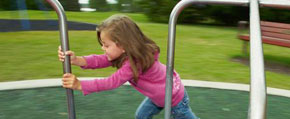We are pleased to announce an exciting new alliance between Active Living Research and GP RED to co-host and coordinate...
Explaining Gender Differences in Bicycle Behavior
Presentation at the 2009 Active Living Research Annual Conference
Background:
In light of rising gas prices and concerns over climate change, bicycling is seeing a resurgence of popularity. Although driven by economic motivations, this trend could have significant health benefits. But if current cycling patterns hold, men will be doing much more bicycling than women. Surveys consistently show that in the U.S. men bicycle more than women, by a ratio of at least 2:1. In contrast, researchers have noted that industrialized countries such as the Netherlands, Denmark and Germany, with higher rates of bicycling for both transportation and recreation, have equal or higher rates of female cyclists than males. Studies suggest that differences in bicycle infrastructure as well as auto-oriented culture explain differences in the rate at which women bicycle relative to men in these countries. However, evidence on differences in the factors influencing bicycling for men and women is limited.
Objectives:
The overall aim of the project is to identify factors that explain differences in bicycling between men and women in the U.S.
Methods:
Study Design: This study uses data from a cross-sectional survey conducted on-line in 2006 in six small cities in the western U.S. Setting: Six cities were selected for their similarities with respect to size, weather, and topography but differences with respect to bicycling culture and infrastructure: Davis, Woodland, Chico, and Turlock in California, Eugene, OR, and Boulder, CO.
Measures: The dependent variable is biked or not within the last seven days. The explanatory variables were categorized as individual level factors (both socio-demographic characteristics and attitudes), physical environment factors, and social environment factors.
Analysis: Logistic regression was used to model bicycling-or-not for women only, men only, a pooled model, and a final pooled model with interaction terms.
Results:
Consistent with previous studies, men biked considerably more than women, with 59.7% versus 40.3% bicycling the last week, respectively. The final model suggests that many of the same factors explain bicycling for men and women. Agreement with the statement “I like biking” has a strong influence for both men and women, and the effect does not differ by gender (OR = 3.935; 5-point scale). Two factors are significant predictors of bicycling for women but not men: bicycling comfort (OR = 7.046; 3-point scale), and agreement with the statement “I need a car to do many of the things I like to do” (OR = 0.585; 5-point scale). Conversely, two factors are significant predictors of bicycling for men but not women: biked in youth (OR = 5.138) and relative importance of bicycle environment when choosing a community, a measure of self-selection (OR = 2.326).
Conclusions:
The importance of bicycling comfort for women but not for men is consistent with previous research and suggests a need for greater attention to comfort though an emphasis on off-street facilities and bicycle lanes on streets with low traffic volume in order to increase bicycling among women. On the other hand, the results suggest that family obligations for women that often necessitate driving (whether to chauffer children or pick up groceries) limit the degree to which women are able to bicycle. Efforts to increase bicycling for children and to promote the use of trailers for children and/or for groceries and other cargo might help to facilitate bicycling for women.
Support:
The research was supported by a grant from the Sustainable Transportation Center at the University of California Davis, which receives funding from the U.S. Department of Transportation and Caltrans, the California Department of Transportation through the University Transportation Centers program.
STAY UP TO DATE
RECENTLY ADDED TOOLS & RESOURCES
MOVE! A BLOG ABOUT ACTIVE LIVING
The "Active Living Conference" aims to break down research and practice silos and...







